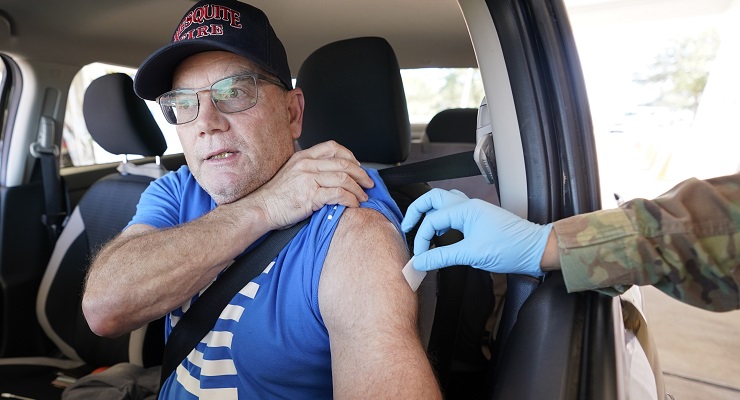
As the second year of the COVID-19 pandemic draws to a close, Australia ranks among the countries that have best navigated the crisis. Viewed from afar, it seems not all Australians share that view.
Certainly Australia’s success has not been achieved without significant hardships and sacrifices. Melbourne endured the longest cumulative lockdown in the world. Sydney also weathered extended confinement. The entire nation shared similar restrictions at various times.
International and state borders were closed at short notice. Families were separated. People were stranded. Businesses failed. Jobs were lost. Governments made good choices and bad. Mistakes were made. Some people died as a result.
All this happened. And it was awful. But it was not in vain. The decisions were taken with the singular purpose to protect public health and save lives. By any objective standard, Australia’s collective response has been a triumph.
It can be hard to assess outcomes in real time — that’s task is usually left to historians. It’s difficult to parse facts without knowing where the road not travelled might have led. In the absence of such information, a proxy serves as a useful guide.
Australia is often likened to Texas for its rugged terrain, harsh climate, deep roots in agriculture and mining, and a culture of self-reliance and can-do spirit.
Texas’s population of almost 30 million is 15% larger than Australia’s 26 million. Three-quarters of Texans reside in the six largest metropolitan areas, while two-thirds of Australians do the same. Both have similar scale diversified economies, with GDPs of $60,000 per capita. Texas is more compact, but at three times the size of Victoria has only 50% greater population density than Australia’s garden state.
In 2019, before the virus struck, 169,301 Australians died. That same year 203,099 Texans died, 20% more than Australia’s toll. Texas’ worse mortality rate is due primarily to disparities in population health and access to medical care compared with Australia.
These similarities make Texas a suitable surrogate to evaluate Australia’s pandemic response. From a public health perspective, Australia has crushed Texas. It’s not even close.
More Texans have died of COVID in the past month than Australians in the past two years. During the worst surges, more Texans died in a single week. According to official figures, 75,000 Texans have been killed by the virus. Based on excess deaths and data from the Centers for Disease Control and Prevention, experts believe this figure to be 27%-33% below actual. This makes the real tally between 95,000 and 100,000 dead. That’s a huge leap above Texas’s pre-pandemic death rates.
COVID is now the third leading cause of death in Texas, after heart disease and cancer. This from a virus that was unknown two years ago. Far from receding into the rear-view mirror, the pandemic appears set to continue wreaking havoc in the Lone Star State. With winter’s onset, and after Thanksgiving travel and family gatherings, another wave looms. The emergence of the Omicron variant compounds the threat.
Of course, death rates are a crude measure of the health consequences inflicted. Medical authorities estimate that half those who contract COVID-19 experience long-term side effects. Some indications, such as fatigue or sensory impairment, may sound mild to onlookers but sufferers assure us their symptoms can be debilitating. Victims have had their lungs or other organs ravaged, requiring transplants. Those admitted to intensive care units and intubation face gruelling and uncertain recoveries. These patients are all but invisible to us. So is the immense cost burden imposed upon them and the medical system.
How did Texas fail so miserably? The primary reason is that the pandemic was politicised from the start. Following the lead of then-president Donald Trump, who viewed COVID as a threat to his reelection prospects and downplayed it at every turn, Texas Republicans have opposed public health measures throughout.
Texas Governor Greg Abbott refused to impose a statewide stay-at-home mandate, leaving it to city and county officials to adopt a patchwork response. When he disagreed with their decisions, he attempted to use his executive authority to overrule them. Abbott and his allies have fought mask and vaccine requirements. They have backed claims for religious exemptions to both. Contact tracing and mandatory quarantines never happened. No fines were ever issued.
Despite the worst pandemic in a century, the Texas legislature didn’t meet in 2020. Like most US states, Texas legislators are considered part-time officials with regular day jobs. Running the second largest state in the union is their side gig. The governor can summon them into session for urgent business, but neither he nor his Republican colleagues considered COVID sufficient cause to assemble.
Some localities and school districts have pushed back and won court battles to permit their mask and vaccine rules. In response several Republican politicians have asked Abbott to convene a special session so they can pass a law to ban mandates. That’s their idea of how to protect Texans mired in a deadly pandemic.
Vaccination rates expose another catastrophic failure. Despite having the world’s earliest and most widespread access to multiple clinically proven vaccines — a modern scientific marvel — only 65% of Texans have received one dose. Just 55% are fully vaccinated after an entire year. New vaccinations proceed at a glacial pace. This isn’t even the worst performance in the United States. Texas ranks mid-pack of the 50 states.
In contrast, Australians — after the federal government’s initial sloppy management of vaccine sourcing and distribution delayed their availability for several months — have lined up in droves for the vaccine; 81% have received a shot, and 88.7% of those over 16 are fully vaccinated.
As Australians resume their lives with robust protections and precautions, infections are surging in Texas and deaths continue to mount.
Public conduct has devolved into a DIY buffet, absent any meaningful public health compliance or enforcement. Republican politicians and right-wing shills continue to pander to minority fringe anti-maskers and anti-vaxxers. They are prolonging the pandemic and killing people needlessly for political gain.
Australians should be thankful to have dodged this nightmare; 8000 fewer Australians died in 2020 than in 2019, a stunning statistic in the midst of a global health disaster. If Australia had mimicked Texas’s lax example, a further 75,000 Australians could have perished.
That means north of 80,000 Australians are still alive to celebrate Christmas with their families. That’s more than died in either of the world wars. It’s five times the number lost to Spanish influenza 100 years ago.
There’s no telling who would have been lost. But few Australians would have been untouched by the death of a friend, colleague or loved one. For all the weariness, frustration and cynicism, those lives saved are a priceless Christmas miracle that should make all Australians proud.








Crikey should put this story up on the site for free so that we can send links to any anti-vaxers we know (sigh) and all our friends in the States … and elsewhere
Absolutely, Roberto!!! I could not agree more!!
I hope that some of the knockers here at Crikey read this very sobering piece which puts our experience into some perspective.
Keir is to be congratulated for this excellent piece of journalism. (I do not know how he retains his sanity living in that lunatic asylum, aka the United States.)
Thanks for this. Puts things into perspective. And makes me even more grateful that I live in Perth.
You are right catoke.
The contrast between the way W.A. Premier Mark McGowan and many of the Governors, (not to mention the immediate past President) in the United States have handled this crisis could not be more stark. The criticism that Premier McGowan sometimes receives should be treated with the absolute contempt and derision that it deserves.
The cynical would say that you can’t get an abortion, a blow job, or a brain in Texas. But then, we look at George Christensen…
I think you should reconsider on the blowjob aspect. Moral and religious zealousness in a society tends to go hand in hand (apologies) with pornography and prostitution. The USA is a fair example of this.
By the way – apparently the biggest consumers of pornography in the world are Saudi men – although I am not sure how the stats are collected.
IPNs.
As Meathead might sing, “Two outa 3 ain’t bad!”.
Why do I imagine that the Member for Manila was nonetheless gypped?
And these two US States are pushing for strict anti-abortion laws because ‘life is sacred’!
Every day in the Murdoch press there are multiple articles decrying almost any action taken by a State Government, (especially of the Labor variety), intended to contain Covid. Everything from vaccine mandates to Border closures, to mask wearing. And Social Media is awash with Conspiracy theories around Covid.
It is an indictment on our Society that so many are led astray from the above.
Melbourne must be the headquarters of extremists and conspiracy theorists, as they’re the ones doing most of the organisation of the large Protests we have seen that complain about their “freedoms” being eroded, and Authoritarian Governments. One wonders whether these people would survive at all in a number of other Countries around the World, where there Freedoms are limited, and their Governments a lot further down the path of Authoritarianism than Australia.
These people need to look at what is happening in other parts of the World.
This article about Texas is an example of what is happening in the United States – The Land of the Free.
Australia’s respnse to Covid hasn’t been perfect, but its been a far cry than the majority of other Countries around the World.